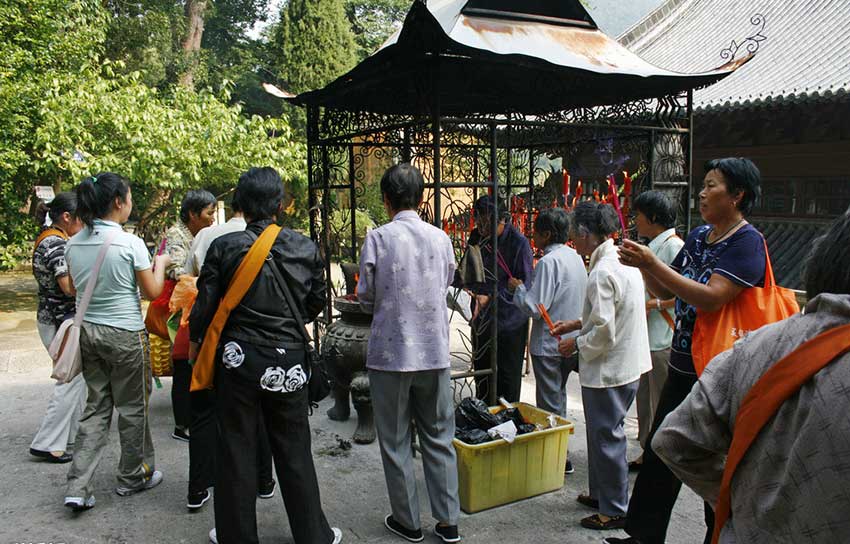Guoqing Temple of Tiantai Mountain
The Guoqing Temple(国清寺) of Tiantai Mountain, Zhejiang province, China is a Buddhist temple originally built in 598 AD during the Sui Dynasty, and renovated during the reign of the Yongzheng Emperor (r. 1722-1735 AD) of the Qing Dynasty. It is located roughly 220 km from the city of Hangzhou. It was the initial site for the creation of the Tiantai Mahayana Buddhist school, founded by Zhiyi (智顗; 538-597 AD). The temple covers a square surface area of some 23000 square m (75440 ft squared). The temple features 600 rooms in a total of 14 different halls, including the Grand Hall of Sakyamuni, the Hall of Five Hundred Arhats, the Hall of Monk Jigong, etc. The exterior of the temple features Chinese pagodas such as the Sui Pagoda, the Seven Buddha Pagoda, and the Memorial Pagoda of Monk Yi Xing (683-727 AD).
This mountain temple is the site where indigenous Chinese Buddhism branched away from Buddhist teachings and doctrine commonly found in India. From there, the Tiantai sect of Buddhism spread to both Korea and Japan during the Tang Dynasty (618-907 AD). The tall brick Guoqing Pagoda built at the temple in the year 597 is still standing,making it one of the oldest surviving brick pagodas in China (after the 40 m tall Chinese Songyue Pagoda built in 523 AD).
Guoqing Temple is located at the foot of the southern side of Tiantai Mountain, Zhejiang Province, China, and is the cradle of Buddhism’s Tiantai Sect in China and Japan. In 1983, this temple was designated one of national key temples in the areas of the Han nationality by China’s State Council.
Guoqing Temple was built in 598 in the Sui Dynasty (581-618) in accordance with the design chart drawn by Zhiyi, the founder of Tiantai Sect. Since the Tang Dynasty, it has experienced several rises and declines. The existing buildings were those rebuilt in the twelfth year (1734) of the Yongzheng reign of the Qing Dynasty.
Guoqing Temple covers an area of 19,600 square meters and has more than 600 rooms. It is one of the most integrated large-scale temples in China. Its main body consists of four vertical axes and such main buildings as Maitreya Buddha Hall, Main Hall, Kwin-yin Hall, Bell Tower, Drum Tower, Abbot’s Room, Sutra Hall, etc. stand on these axes. The Statue of Sakyamuni in the Main Hall is cast by bronze, and weighs thirteen tons. Eighteen arhats sitting on both sides of Sakyamuni are engraved with Nanmu (Phoebe Zhennan, a kind of rare tree), and covered with real gold leaves. The fresco Leading People from Earthliness to Buddhism behind the statue of Sakyamuni is drawn delicately, and has a high artistic value. A plum pavilion stands on the left side of the Main Hall, and there is an ancient plum tree in the parterre in the front of the pavilion. It is said that the plum tree, with an age of more than 1,300 years, was planted by the first abbot of this temple in the Sui Dynasty; therefore, it has a popular name: Sui Plum. Maybe it is the oldest extant plum tree in China.
Guoqing Temple takes an important position in the history of Sino-Japan Buddhist exchanges. 1,200 years ago, Jianzhen, an accomplished monk in the Tang Dynasty (618-907), crossed sea to Japan with a large number of sutras from Guoqing Temple. Before he went to Japan, he made a pilgrimage to Guoqing Temple, and formally acknowledged its abbot as his teacher. In the 20th year (804) of the Zhenyuan reign of the Tang Dynasty, Zuicheng, an accomplished Japanese monk, came to Guoqing Temple for Buddhist scriptures. After he came back to Japan, he founded the Tiantai Sect, and built Yanli Temple by following the style of Guoqing Temple. Yanli Temple is Japan’s Guoqing Temple, and the Tiantai Sect in Japan reputes Guoqing Temple in China as its birthplace. Following Zuicheng, a number of Japanese master monks came to Tiantai Mountain in succession to seek Buddhist doctrines. In the latest 20 years, personages of the Buddhist circle in Japan visited Guoqing Temple on Tiantai Mountain several times.
Source: Wokipedia
OPENING HOURS
| Week Days | 8:00 – 5:00 |
| Saturday | 9:00 – 5:00 |
| Sunday | 11:00 – 4:00 |




















